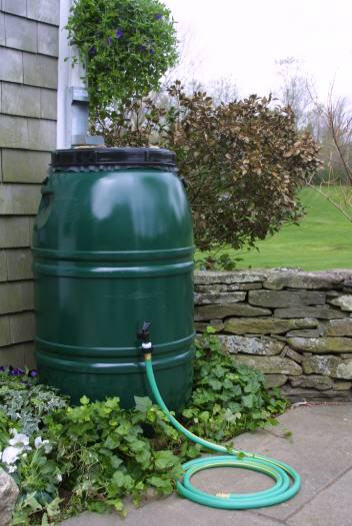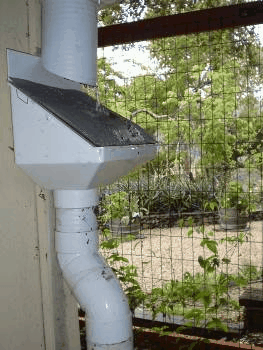- TABLE OF CONTENTS
- REDUCE YOUR WATER NEEDS
- Use Drought Tolerant Plants
- California Native Plants
- Climate Zones
- Reduce or Replace Lawn
- Artificial Turf
- IRRIGATE EFFICIENTLY
- Water Needs of Plants
- Before You Design
- Types of Irrigation Systems
- Weather Based Irrigation Controllers
- Working with an Irrigation Contractor
- DEVELOP ALTERNATE SOURCES OF WATER
- RETAIN WATER IN THE LANDSCAPE
- Build Retaining Walls
- Mulch to Reduce Evaporation
- Install Permeable Hardscapes
- Amend Soil with Organic Materials
- KEEP YOUR WATER PURE
- Drainage
- Eliminate Runoff and Overspray
- Slow it, Spread it, Sink it
- Ocean Friendly Gardens
- Rain Gardens
- Swales
- Keep Your Watershed Beautiful
- Soil
- Pests
- Select Plants that Don't Need Chemicals
- ADDITIONAL GARDENING RESOURCES
Harvest Rain Water
Rainwater Collection – Store rainwater for garden irrigation
Rainwater collection from roofs or other surfaces can be stored for later use in your garden. Captured water can be used for irrigation or other non-potable options or metered off slowly after storm events to allow for infiltration and reduced flooding. The larger the container, the more water you can store to irrigate your garden throughout the dry summer and reduce the water used from the tap.
HOW MUCH RAIN CAN YOU CATCH?
To estimate the amount of water you can collect from your roof use this calculation:
Area of roof in square feet × 0.625 gallons of water = gallons caught per inch of rain. So a 1,000 square foot roof would drain 625 gallons for an inch of rain.
Then multiply the inches of annual rainfall to get the total rooftop potential. This is just an estimate since some water is lost to splashing and overflow in heavy rainstorms. Santa Cruz County gets on average of 31" of rain per year. Santa Cruz County has microclimates as you can see by the average rainfall in different parts of the County. The City of Watsonville gets on average rainfall of 22.41", Santa Cruz City gets on average 30.58", Boulder Creek gets 47.68" and Ben Lomond gets 49" per year!
STORAGE CHOICES AND CONSIDERATIONS:
Rainwater can be stored in containers above ground or below ground to be pumped, siphoned off or flow by gravity for use in irrigation or in some creative installations, brought to the plant’s root zones by capillary action from buried water retention trays. Here are some basics about rainwater storage and maintenance to consider.
RAIN BARRELS are small- to medium-sized containers placed outside buildings and connected to roof downspouts to collect runoff for later use in non-potable applications. Rain barrels have many advantages in urban settings. They take up very little space, are inexpensive, and easy to install. Rain barrels conserve water and reduce the volume of runoff moving off-site. One barrel won’t store enough water for average summer irrigation demands, but combine the storage of several barrels and a water smart garden to make it last longer.
 |
Rain barrels come in many shapes and sizes and can be a simple container under a downspout with an outlet faucet.
MAINTENANCE: Rain barrels should have a pre-filter or first-flush device installed to keep out organic debris. If a first-flush device or pre-filter is not used, the container should be drained after the first rainfall to remove any organic material built up on the roof over the dry season. Screens should be regularly cleaned to remove leaves and debris collected on screens. Always check that the overflow is clear and directed to an appropriate location that won’t cause erosion or drain into the foundations of buildings. Make sure your container’s screen does not have holes to allow mosquitoes to breed.
 |
DO
• Use water regularly (e.g., water indoor plants).
• Use gravity to your advantage.
• Use multiple barrels where possible.
• Keep covered to eliminate debris and mosquito breeding.
DON’T
• Allow access for mosquitoes, rodents, children, pets, or debris.
• Use for drinking.
• Capture water from roofs with excessive debris (e.g., leaves, pine needles, or bird droppings.)
WATER TANKS (CISTERNS) are manufactured water storage containers for non-potable use in residential, commercial, or industrial applications. Water tanks can be installed both above and below ground. Some tanks come as sectional pieces that can be put together to fit different space constraints. Tanks can be used with most guttered roofs to collect runoff and reduce runoff volume.
Above ground tanks: Both water tanks and rain barrels can be used without pumping devices, instead relying on gravity flow. However, depending on the desired use for the water, a pump may be necessary for best performance especially if overhead sprinklers are used in the garden. Larger tanks can be designed to also function as privacy screens, fences, or small retaining walls. Tanks can also be hidden under decks, planters or serve as the foundation for play structures or other landscape features. Get creative!
Content from:
Idcide. Boulder Creek California, Weather Available: http://www.idcide.com/weather/ca/boulder-creek.htm. Retrieved January 2009.
Kinkade-Levario, Heather. Design for Water: Rainwater Harvesting, Stormwater Catchment, and Alternate Water Reuse. New Society Publishers, 2007
Rehbein Environmental Solutions Inc. EPIC System. Online. Available: http://www.rehbeinsolutions.com/technology/epic.html retrieved January 2010.
Resource Conservation District of Santa Cruz County. (2009). Slow it. Spread it. Sink it! A Homeowner’s Guide to Greening Stormwater Runoff (first ed.). Santa Cruz County, CA.
Wikipedia. Climatography of the United States. National Climatic Data Center. Available: http://ggweather.com/climate/santa_cruz.pdf. Issue date February 2004.